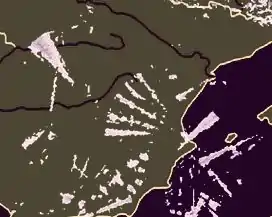Dynamic frequency selection
Dynamic Frequency Selection (DFS) is a channel allocation scheme specified for wireless LAN, commonly known as Wi-Fi. It is designed to prevent electromagnetic interference with other usages of the C band frequency band that had predated Wi-Fi, such as military radar, satellite communication, and weather radar.[1] It was standardized in 2003 as part of IEEE 802.11h.

Mechanism
The actual mechanism, radar pulse pattern, power level, and frequency band on which it is enforced varies by country and jurisdiction.[2] For example, DFS is mandated for the 5470–5725 MHz U-NII band in United States by the FCC.[3]
The access points would automatically select frequency channels with low interference levels based on regulatory requirement. In case of radar detection, the access point would switch channel if it is configured to automatically select channel. If channel selection was done manually, DFS would cause access point to go offline.
Weather radar interference
Prior to the introduction of Wi-Fi, one of the biggest applications of the 5 GHz band was Terminal Doppler Weather Radar.[4][5] The decision to use 5 GHz spectrum for Wi-Fi was finalized in the World Radiocommunication Conference in 2003; however, the meteorological community was not involved in the process.[1][6] The subsequent lax implementation and misconfiguration of DFS caused significant disruption in weather radar operations in a number of countries around the world. In Hungary, the weather radar system was declared non-operational for more than a month. Due to the severity of interference, South African weather services ended up abandoning C band operation, switching their radar network to S band.[5][7]
References
- Touw, Ron (Nov 16, 2016). "Radar Detection and DFS on MikroTik" (PDF). Radar Detect and DFS on MikroTik. MikroTik. Retrieved 4 December 2019 – via YouTube.
Decision ERC/DEC/(99)23 adds 5250-5350MHz and 5470-5725MHz with more Tx power but with the added caveat that DFS was required to protect legacy users (Military Radar and Satellite uplinks)
- "DFS (Dynamic Frequency Selection)". Linux Wireless Wiki. Retrieved 5 December 2019.
- "5GHz agreement". Ntia.doc.gov. 2003-01-31. Retrieved 2012-08-29.
- Spain, Chris (July 10, 2014). "Winning Back the Weather Radio Channels Adds Capacity to 5GHz Wi-Fi Spectrum - Cisco Blogs". Cisco Blogs. Cisco. Retrieved 4 December 2019.
The FCC ruling is re-opening the Terminal Doppler Weather Radar (TDWR) band (channels 120, 124, 128) with new test requirements for DFS protection.
- Saltikoff, Elena (2016). "The Threat to Weather Radars by Wireless Technology". Bulletin of the American Meteorological Society. 97 (7): 1159–1167. doi:10.1175/BAMS-D-15-00048.1. ISSN 0003-0007.
Since 2006, interference to C-band radars from RLAN is increasingly experienced by most OPERA members. ... The South African weather services initially tried to implement specific software filtering to improve the situation but then decided in 2011 to move its meteorological radar network to S band.
- Tristant, Philippe (23–24 October 2017). "C-band meteorological radars - Threats related to RLAN 5 GHz" (PDF). EUMETNET. Retrieved 5 December 2019 – via itu.int.
- Tristant, Philippe (16–18 September 2009). "RLAN 5 GHz interference to weather radars in Europe" (PDF). International Telecommunication Union. Retrieved 4 December 2019.
More than 12 European countries experienced such interference cases (other cases have now been reported in number of countries in the world). Definitively harmful interference (in Hungary, the radar was declared as non-operational for more than 1 month)